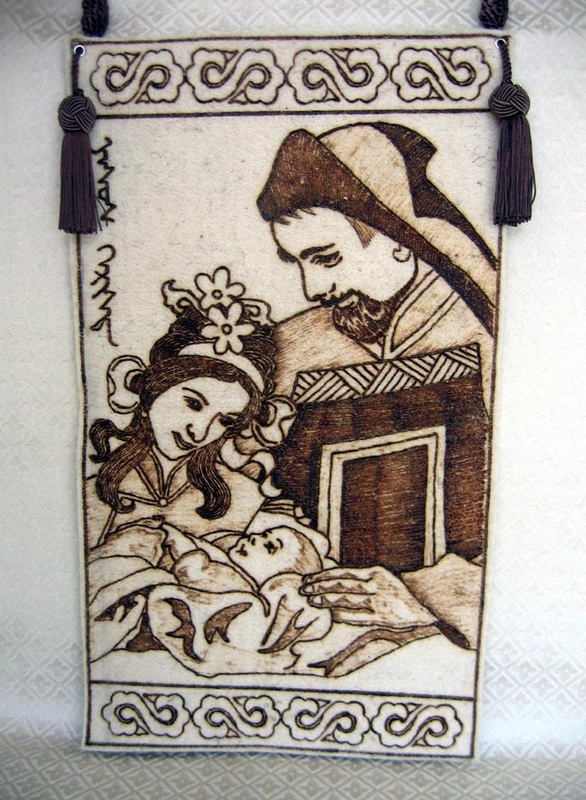OUR COLLECTION — ASIA — MONGOLIA 77. WOOL HANGING HOLY FAMILY (MONGOLIAN)
This handmade hanging of the Holy Family comes from Mongolia. The pattern is burned onto sheep wool felt using wood-burning tools. The hanging measures 20.5 inches tall by 12 inches wide.
The hanging was made by our friend Bayaraa, a disabled Christian artisan in Mongolia. (Mongolians do not use last names.) Bayaraa is disabled from a back injury and must use a wheelchair. He lives in a ger, which is a traditional Mongolian nomadic tent. He signed his name on the back of the wall hanging using the Russian Cyrillic alphabet.
The design depicts the Holy Family in native Mongolian dress. Mary’s costume reflects the lavish Mongolian married woman’s headdress resembling wild sheep horns or wings. The wing motif has an aesthetic symbolism, derived from a legend about a woman who looks like a bird with two wings who is protecting the hearth. The Mongolian name for the headdress is usnii daruulga, which means that it covers hair.
Another feature of great interest is the script written on the upper left side of the hanging. While Mongolians have used the Russian Cyrillic alphabet since the early Twentieth Century when Russia invaded Mongolia, the Mongolian people also have an ancient Mongolian script. The script on this hanging means "Jesus Christ" in the Mongolian Old Script.
The hanging was made by our friend Bayaraa, a disabled Christian artisan in Mongolia. (Mongolians do not use last names.) Bayaraa is disabled from a back injury and must use a wheelchair. He lives in a ger, which is a traditional Mongolian nomadic tent. He signed his name on the back of the wall hanging using the Russian Cyrillic alphabet.
The design depicts the Holy Family in native Mongolian dress. Mary’s costume reflects the lavish Mongolian married woman’s headdress resembling wild sheep horns or wings. The wing motif has an aesthetic symbolism, derived from a legend about a woman who looks like a bird with two wings who is protecting the hearth. The Mongolian name for the headdress is usnii daruulga, which means that it covers hair.
Another feature of great interest is the script written on the upper left side of the hanging. While Mongolians have used the Russian Cyrillic alphabet since the early Twentieth Century when Russia invaded Mongolia, the Mongolian people also have an ancient Mongolian script. The script on this hanging means "Jesus Christ" in the Mongolian Old Script.
